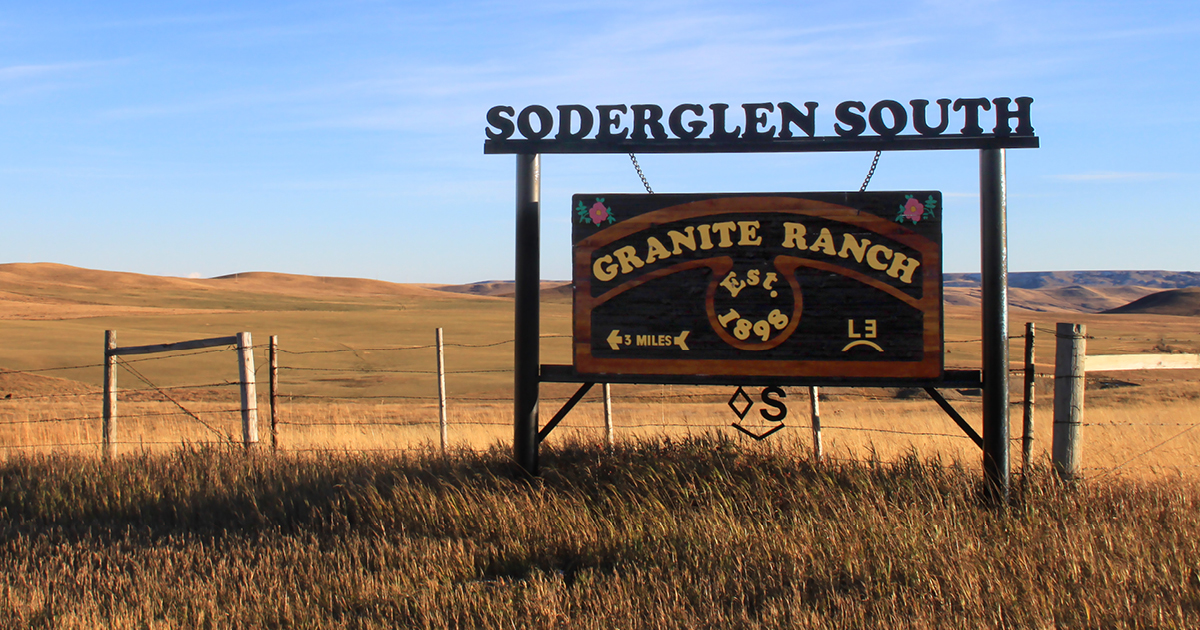AB Direct - Steers
Rail: 492.00-498.50 FOB feedlot (last week)
AB Direct - Heifers
Rail: 492.00-498.50 FOB feedlot (last week)
US Trade- Steers
Rail: 380.00 NE, IA (last week)
US Trade - Heifers
Rail: 380.00 NE, IA (last week)
Canadian Dollar
0.04

ABP awards 2021 Environmental Stewardship Award of distinction to Soderglen South
Since 1992, Alberta Beef Producers (ABP) has recognized and awarded cattle operations that demonstrate exemplary environmental stewardship in the province. In April at a Producer Town Hall, the organization presented the Environmental Stewardship Award (ESA) to Scott and Elan Lees of Soderglen South.
With every passing year, the dedication of Alberta ranchers to environmental stewardship raises the bar. This year is no different. Soderglen South, co-owned by Scott and Elan Lees, operates two ranch sites on 15,000 acres in the Alberta Foothills Fescue sub-region, on primarily native prairie grassland with numerous wetland basins, where conservation is a high priority.
Like previous ABP ESA winners, Soderglen South practices exemplary environmental stewardship, contributing to the success and sustainability of our industry. The Lees, together with their family and a small team of employees, maintain a herd of 1,500 mother cows from five different seedstock lines. They summer the herd southwest of Fort Macleod, and use their second location, southeast of Cardston, as the base for wintering and calving. The herd goes to Soderglen North at Airdrie, in the fall, where heifers are bred and sent back south. All animals are entirely grass fed. On every acre, the Lees have made considerable
effort to both maximize grass production and support environmental sustainability. Each time they purchase land, they make it a priority to make changes to improve grass production sustainably, explains Scott Lees. “We always start by asking: What can we improve? Which areas have been negatively impacted? What’s working well? Then we strategize, not only to maximize production, but also to provide riparian protection, drought-proof and set up better rotational grazing patterns,” he says.
These changes, Lees says, always include: considering riparian protection, putting in fencing to protect water sources, adding solar-panel-operated water systems, and setting up water pipelines. “All our ranchland now has water on every quarter—which took many miles of pipeline,” says Lees. “In addition to all those miles of pipeline, water delivery has required springs to be developed and dugouts to be set up. It’s a long endeavour.”
Stewardship is a future-focused imperative
Stewarding the land environmentally while working animals on it is an important aspect of being successful, Lees notes. “It preserves the equity in your ranch and adds to profitability too. Without either of those, we won’t survive in years ahead.”
Environmental stewardship is a progressive learning process, which means the bar will continue to be raised in the years to come. “Twenty-five years ago, if you had a solar waterer that pumped out of a creek, you were ‘nailing it’. Today, we all have solar waterers—it’s normal. Those primary aspects are still valuable, but to rise to the top is the bigger view of the operation’s environmental impact,” says Chris Israelson, one of ABP’s long term ESA judges.
Award recognizes holistic approach
The ABP ESA recognizes operations that take a multi-faceted approach to environmental stewardship.
Nominees are judged on their management style in a number of areas, including: range/cropland, riparian areas, water protection, wintering, manure, wildlife habitat, and animal welfare. They must also demonstrate community involvement, extension and environmental stewardship activities, goals, and accomplishments.
“The nominees that rise to the top must demonstrate engagement in many levels of stewardship, employing a holistic management style,” says Israelson.
Soderglen South also supports environmental sustainability through other projects and initiatives. In partnership with Ducks Unlimited, they have: set up conservation agreements to maintain native prairie and wetland habitat; converted cropland to perennial forage; restored historically drained wetlands; and established a tenure agreement to mutually benefit wildlife and waterfowl habitat on their land. They also work with the Nature Conservancy of Canada and Pheasants Forever Canada, and 10 years ago, set aside habitat that has helped establish the pheasant population in the St. Mary’s River basin, protecting grizzly habitat in the valley at the same time.
Environmental stewardship is a progressive learning process, which means ABP judges expect the bar will continue to be raised in coming years. “Today, to rise to the top, an operation has to take a broader view of their environmental impact, and be acting on it in a variety of ways,” Israelson notes.
This article was originally published in the May 2021 edition of ABP Magazine. Keep an eye on ABP Daily for more content from the magazine, and update your contact information to receive the next issue.

